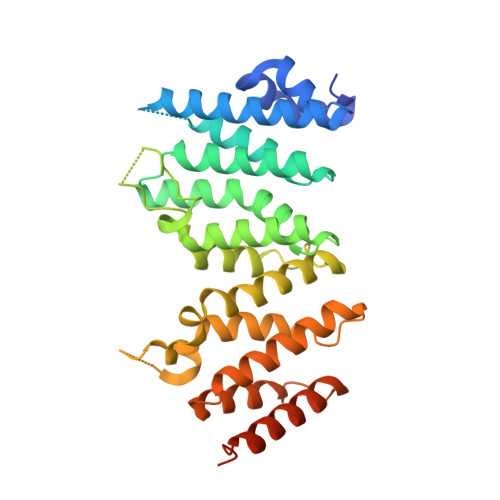A cryptic tubulin-binding domain links MEKK1 to curved tubulin protomers.
Filipcik, P., Latham, S.L., Cadell, A.L., Day, C.L., Croucher, D.R., Mace, P.D.(2020) Proc Natl Acad Sci U S A 117: 21308-21318
- PubMed: 32817551
- DOI: https://doi.org/10.1073/pnas.2006429117
- Primary Citation of Related Structures:
6WHB - PubMed Abstract:
The MEKK1 protein is a pivotal kinase activator of responses to cellular stress. Activation of MEKK1 can trigger various responses, including mitogen-activated protein (MAP) kinases, NF-κB signaling, or cell migration. Notably, MEKK1 activity is triggered by microtubule-targeting chemotherapies, among other stressors. Here we show that MEKK1 contains a previously unidentified tumor overexpressed gene (TOG) domain. The MEKK1 TOG domain binds to tubulin heterodimers-a canonical function of TOG domains-but is unusual in that it appears alone rather than as part of a multi-TOG array, and has structural features distinct from previously characterized TOG domains. MEKK1 TOG demonstrates a clear preference for binding curved tubulin heterodimers, which exist in soluble tubulin and at sites of microtubule polymerization and depolymerization. Mutations disrupting tubulin binding decrease microtubule density at the leading edge of polarized cells, suggesting that tubulin binding may play a role in MEKK1 activity at the cellular periphery. We also show that MEKK1 mutations at the tubulin-binding interface of the TOG domain recur in patient-derived tumor sequences, suggesting selective enrichment of tumor cells with disrupted MEKK1-microtubule association. Together, these findings provide a direct link between the MEKK1 protein and tubulin, which is likely to be relevant to cancer cell migration and response to microtubule-modulating therapies.
- Biochemistry Department, School of Biomedical Sciences, University of Otago, 9054 Dunedin, New Zealand.
Organizational Affiliation:


















